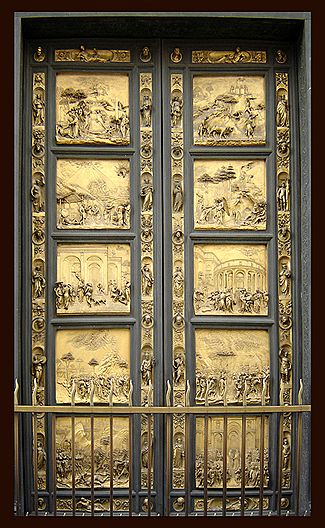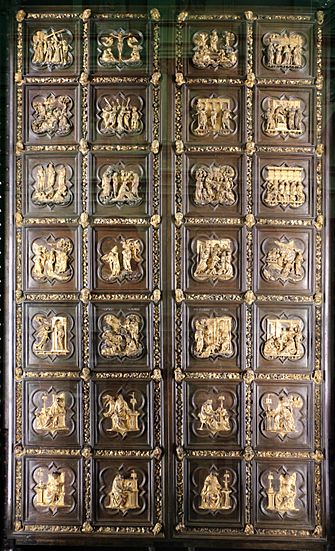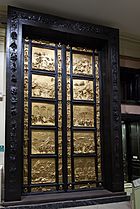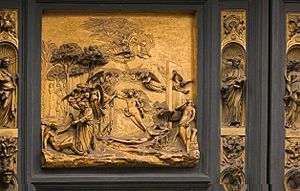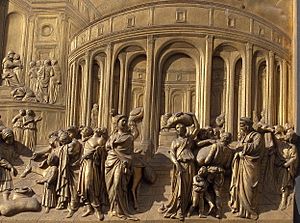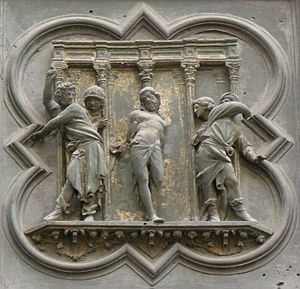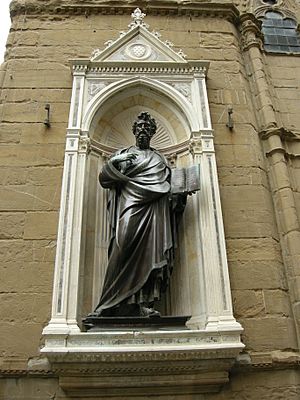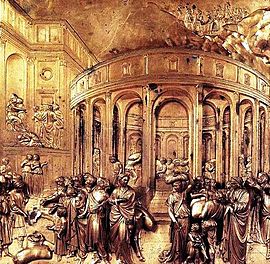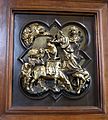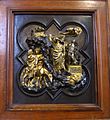Lorenzo Ghiberti facts for kids
Quick facts for kids
Lorenzo Ghiberti
|
|
|---|---|
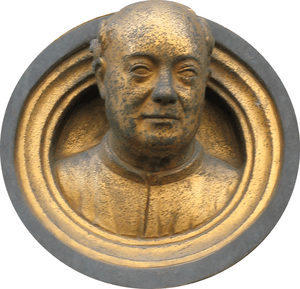
Lorenzo Ghiberti on Gates of Paradise
modern copy Florence Baptistery |
|
| Born |
Lorenzo di Bartolo
1378 Florence, Republic of Florence
|
| Died | 1 December 1455 (aged 73–74) Florence, Republic of Florence
|
| Nationality | Italian |
| Known for | Sculpture |
|
Notable work
|
Gates of Paradise, Florence Baptistery |
| Movement | Early Renaissance |
Lorenzo Ghiberti (1378 – 1 December 1455), born Lorenzo di Bartolo, was a famous Italian Renaissance sculptor from Florence. He was a very important artist during the Early Renaissance. Ghiberti is best known for creating two sets of amazing bronze doors for the Florence Baptistery. The second set of doors was even called the Gates of Paradise by the famous artist Michelangelo.
Ghiberti started his career as a goldsmith and sculptor. He built a very important workshop where he created sculptures out of metal. He also wrote a book called Commentarii. This book contains important writings about art and is believed to be the first autobiography ever written by an artist.
Ghiberti's most famous works were the two sets of bronze doors for the Florence Baptistery (Battistero di San Giovanni). These doors are seen as major masterpieces of the Early Renaissance. They became famous and influenced many artists right after they were finished.
Contents
Early Life and Artistic Beginnings
Lorenzo Ghiberti was born in 1378 in Pelago, a town near Florence. He was raised by his stepfather, Bartolo di Michele, who was a skilled goldsmith in Florence. Bartolo taught Lorenzo the first steps of design and art.
Lorenzo was interested in many types of art, not just working with gold. He loved making copies of old medals and also enjoyed painting. He even received formal training as a painter from Gherardo Starnina.
In 1400, when the bubonic plague hit Florence, Ghiberti moved to Rimini. There, he worked for Carlo I Malatesta, helping to paint frescoes on castle walls. This experience made him love painting even more. However, he soon heard exciting news from Florence. The leaders of the Baptistery were holding a competition for artists skilled in bronze work. Ghiberti quickly returned to Florence to join the competition.
The Famous Florence Baptistery Doors
Ghiberti became famous at just 21 years old when he won the 1401 competition. This competition was to create the first set of bronze doors for the Florence Baptistery. Another famous artist, Brunelleschi, was the runner-up. The original idea was for the doors to show scenes from the Old Testament, but this was changed to scenes from the New Testament. However, Ghiberti's trial piece, which still exists, shows the sacrifice of Isaac.
To complete this huge project, Ghiberti set up a large workshop. Many famous artists trained there, including Donatello, Paolo Uccello, and Antonio del Pollaiuolo. After finishing the first set of twenty-eight panels, Ghiberti received a second commission. This time, he was asked to make another set of doors for a different entrance of the church. These doors would show scenes from the Old Testament, as originally planned for the first set.
Instead of twenty-eight scenes, Ghiberti created ten large rectangular scenes for the second set. These new panels were much more realistic. They used perspective to create depth and showed a greater sense of beauty. Michelangelo famously called this second set "The Gates of Paradise." These doors are a major symbol of the Renaissance humanism period.
The Gates of Paradise have ten panels, each showing several events from a specific Old Testament story.
Here is a list of the stories on the Gates of Paradise:
| Adam & Eve | Joseph |
| Cain & Abel | Moses |
| Noah | Joshua |
| Abraham | David |
| Isaac & Jacob | Solomon |
Stories on the Gates of Paradise Panels
The Story of Adam and Eve
This panel shows the beginning of Genesis. God created the Universe and the "The Garden of Eden" where the first humans, Adam and Eve, lived. You can see Adam and Eve eating an apple from the forbidden tree. Eve was tricked by Lucifer, who appeared as a serpent, into believing she would become like God if she ate the forbidden fruit.
The Story of Cain and Abel Cain and Abel were the sons of Adam. Abel was younger than Cain. Cain became angry because God preferred Abel's sacrifice over his own. Abel is shown peacefully with his animals. Cain then tricks Abel and murders him.
The Story of Noah God decided to destroy the earth with a flood because it was full of violence. He told Noah to build an Ark. Noah was told to bring two of every animal and his family onto the Ark. The panel shows the waves of the flood and the animals.
The Story of Abraham
Three men, who were actually angels, visited Abraham. They told him that his wife Sarah, who was 80, would have a child. After their son Isaac was born, God asked Abraham to sacrifice him. However, an angel stopped Abraham just in time.
The Story of Isaac Isaac is the son of Abraham. He was almost sacrificed before an angel intervened. The panel also shows Jacob receiving Isaac's blessing. Rebecca is seen listening to God, who tells her about her two sons who will have conflicts.
The Story of Joseph
Joseph was the second youngest of 11 brothers. His father, Jacob, loved him very much and gave him a special robe. His brothers became jealous. Joseph had dreams where his brothers bowed to him, which made them even angrier. They planned to kill him but instead sold him into slavery in Egypt. Joseph later became important in Egypt by explaining the Pharaoh's dreams. He suggested storing food for a coming famine, which saved the city.
The Story of Moses Moses was hidden in a basket in the Nile River by his birth mother. The Pharaoh's daughter found him and raised him. Moses, an Israelite, later led his people out of slavery in Egypt after the 10 plagues struck. They crossed the Red Sea. Moses then received the ten commandments from God on Mount Sinai.
The Story of Joshua After Moses died, Joshua became the leader of the Israelites. He led them to the Promised Land. They crossed the Jordan River. Joshua and his army marched around the city of Jericho seven times, and then the walls collapsed. Joshua and his army took over the city, winning a great victory.
The Story of David Saul was the king of Israel. God chose David to be the next king instead. A war broke out between Israel and Egypt. A giant named Goliath challenged anyone to fight him. David, who was skilled at fighting beasts, killed Goliath with a rock and Goliath's own sword.
The Story of King Solomon King Solomon made an alliance with the Pharaoh of Egypt and married his daughter. God offered Solomon any wish. Solomon asked for wisdom to be a better leader. God rewarded him with great wisdom, and people recognized him as a good and wise king.
Earlier Doors by Andrea Pisano
Before Ghiberti, Andrea Pisano was chosen in 1329 to design the first set of doors for the Florence Baptistery. These south doors were originally on the east side. They have 28 panels, with the top twenty showing scenes from the life of St. John the Baptist. The eight lower panels show eight virtues like hope, faith, and justice. Pisano finished them in 1336.
In 1453, Ghiberti and his son Vittorio were asked to add a decorative frame to Pisano's doors. Ghiberti died in 1455, so his son and workshop finished most of this work.
The 1401 Competition
In 1401, the Arte di Calimala (Cloth Importers Guild) held a competition for new doors. These doors were meant to celebrate Florence being saved from terrible events like the Black Death in 1348. Each artist received brass and had to create a relief of the "Sacrifice of Isaac." They had one year to complete their panel.
Many artists competed, but only seven were chosen as semifinalists, including Ghiberti and Filippo Brunelleschi. In 1402, Ghiberti and Brunelleschi were the only finalists. The judges couldn't decide, so they suggested the two artists work together. However, Brunelleschi was too proud and left for Rome to study architecture. This left the 21-year-old Ghiberti to create the doors by himself. Ghiberti later wrote that he won "without a single dissenting voice."
You can see the original "Sacrifice of Isaac" designs by both Ghiberti and Brunelleschi in the Bargello museum in Florence. Ghiberti's panel was made more efficiently. His figures, except for Isaac, were cast as one piece and were hollow inside. This made his panel stronger, lighter, and used less bronze than Brunelleschi's. These practical differences, along with the artistic quality, helped the judges choose Ghiberti.
After the Competition
After Ghiberti won, his father, Bartolo, helped him perfect the design of the door before it was cast. This project brought Ghiberti immediate fame. In 1403, a formal contract was signed with Bartolo di Michele's workshop, which quickly became the most respected in Florence.
Ghiberti spent 21 years completing the first set of doors. These gilded bronze doors have twenty-eight panels. Twenty panels show scenes from the life of Christ from the New Testament. On April 19, 1424, these doors were placed on the side of the Baptistery. The eight lower panels show the four evangelists and four Church Fathers. The panels are surrounded by beautiful decorations and busts of prophets.
After finishing these doors, Ghiberti was a famous artist. He received many new projects, even from the pope. In 1425, he received a second commission for the Florence Baptistery. This time, it was for the east doors, which he and his workshop worked on for 27 years. These doors show ten large rectangular panels with scenes from the Old Testament. Ghiberti used the new ideas of perspective to make his scenes look very deep and realistic. Each panel tells more than one part of a story. For example, "The Story of Joseph" shows many events from Joseph's life in one panel.
These panels are set in a richly decorated frame of leaves and fruit. There are also many small statues of prophets and 24 busts. Two of the central busts are portraits of Ghiberti himself and his father, Bartolomeo.
Michelangelo famously said these doors were beautiful enough to be the "Gates of Paradise." Giorgio Vasari, a famous art historian, later described them as "undeniably perfect in every way and must rank as the finest masterpiece ever created." Ghiberti himself called them "the most singular work that I have ever made."
Bronze Statues for Orsanmichele
Ghiberti also created large gilded bronze statues for special niches in the Orsanmichele building in Florence.
St. John the Baptist Statue
The St. John the Baptist statue was made between 1412 and 1416. It was ordered by the Arte di Calimala guild, which was the wealthy wool merchants' guild.
This statue was a big step forward in technology for its time. Ghiberti showed amazing skill in casting this 8-foot 4-inch tall bronze statue. Its elegant curves show the influence of the Gothic style popular in Italy.
St. Matthew Statue
The Saint Matthew statue was paid for by the Arte Del Cambio guild, the bankers' guild. It was created between 1419 and 1423.
This bronze statue is 8 feet 10 inches tall and is also located in a niche at the Orsanmichele in Florence. The guild wanted their statue to be as tall as, or taller than, the St. John the Baptist statue.
Later Life and Legacy
By 1417, Lorenzo Ghiberti was married to Marsila. They had two sons, Tommaso and Vittorio. Ghiberti became very wealthy from his success as an artist. He owned land and had money invested in government bonds.
Lorenzo Ghiberti lived to be 75 years old. He died in Florence on December 1, 1455, and was buried in Santa Croce. His son Vittorio followed in his footsteps as a goldsmith and bronze-caster.
Other Important Works
Ghiberti was not only a sculptor but also a collector of old artifacts and a historian. He helped spread Renaissance humanism ideas. His unfinished book, Commentarii, is a very important source of information about Renaissance art. It also contains what is thought to be the first autobiography written by an artist. This book was a major source for Vasari's famous book, Vite.
In his "Commentario," Ghiberti describes how he tried to make his art look as natural as possible, especially with proportions and perspective. He wrote that his buildings "appear as seen by the eye of one who gazes on them from a distance." The way Ghiberti described his art has helped historians understand what Renaissance artists were trying to achieve.
Many artists learned from Ghiberti. Paolo Uccello, known as the first great master of perspective, worked in Ghiberti's workshop for several years. Donatello, another famous sculptor, also worked briefly with Ghiberti. It's believed that Ghiberti's work on perspective was influenced by the Arab scholar Alhazen, who wrote about the science of optics. Alhazen's book was translated into Italian and quoted in Ghiberti's "Commentario terzo."
Images for kids
-
Gates of Paradise, Baptistery, Florence, the doors in situ are reproductions
-
Angled view of a panel with the story of Abraham from the Florence Gates of Paradise (see above)
-
Tomb of Ghiberti in the Basilica of Santa Croce in Florence
See also
 In Spanish: Lorenzo Ghiberti para niños
In Spanish: Lorenzo Ghiberti para niños


